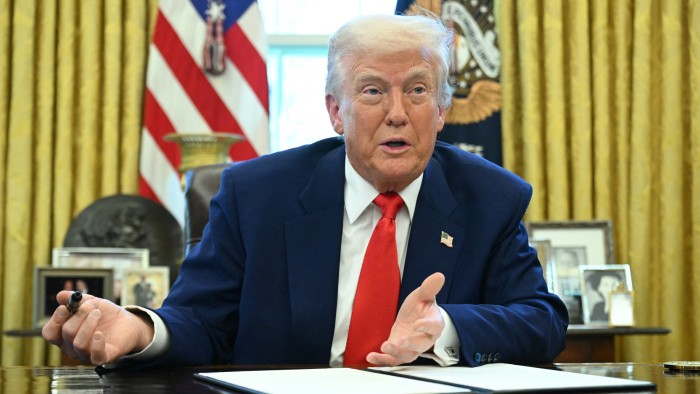Unlock the White House Watch newsletter for free
Your guide to what the 2024 US election means for Washington and the world
Donald Trump called his announcement of huge, self-destructive tariffs “liberation day”. For the financial markets, some liberation from the ensuing days of turmoil came a week later when the US president U-turned, and paused his additional levies on most countries except China for 90 days. The climbdown provided relief, but is no return to business as usual. Further falls in stocks on Thursday reflected nerves over the harm from a trade war between the world’s two largest economies, and a 10 per cent levy on imports from most countries to the US. The damage to the credibility of Trump, and the dollar as a reserve currency, will not be quickly repaired.
Jitters among senior Republicans and business people helped to force the president to blink. Yet the key factor was surely the precipitous slide in the markets — above all the mighty US government bond market. White House officials’ brazen assertions that Trump’s retreat was all part of a grand negotiating strategy were belied by his admissions about people “getting yippy”.
Investors and global policymakers will draw some comfort from the belated re-emergence of the “Trump put”, the notion that adverse reactions from equities or bonds can constrain the president. This should come with caveats. Trump cheered the rebound in US stocks after his backtracking on Wednesday. But another dip on Thursday left them down by double digits this year; in Germany, stocks are up more than 3 per cent. Yields on US Treasuries remained well up from a week ago. That suggests a significant shift in perceptions of US prospects.
Trump’s latest actions betray a far greater appetite for risk in pursuit of highly questionable policies than in his first term. Given it took nearly a week to persuade him to back down, confidence in the US as a rational actor has taken a serious knock.
The temporary pause in additional tariffs for most countries has, moreover, still left in place measures that by any usual standard are extreme. Investors fear the damage to corporate America that doubling the cost of imports from China will bring. The US administration will be under pressure to do quick deals to improve trading terms with the likes of Japan, and eventually Beijing, to show it can ease the pain, and that its policies can bring results.
The concerns are encapsulated by events in the bond market this week; Trump’s analysis that people became a “little queasy” is a lesson in understatement. The US government bond market avoided disaster, but it came close. A reliable rule of investment is that when crisis strikes, Treasuries act as a safety valve by offering a risk-free retreat, so prices rise. After Trump’s tariffs this function failed, and bonds fell.
Investors began to fret openly about the US having compromised its haven status, amid concerns that two of the most reliable buyers of US debt — Japan and China — might sell Treasuries, or tap the brakes on further purchases. Officials close to Trump see the dollar’s reserve status as a double-edged sword; it gives the US unrivalled financial dominance, but also arguably pushes the currency a little too high, squeezing US manufacturing. Yet even for them the risk of the US losing funding, and power, was an alarming one.
Trump’s blunderbuss efforts to reset global trade rattled all the pillars expected of a reserve currency: stability, reliability, robust policymaking and the rule of law. Bond markets responded with a clear warning that regimes do change; a post-dollar world is possible. Rebuilding trust will be hard. After the past week, the continuing market jitters show that US financial dominance can no longer be taken for granted.
Read the full article here
